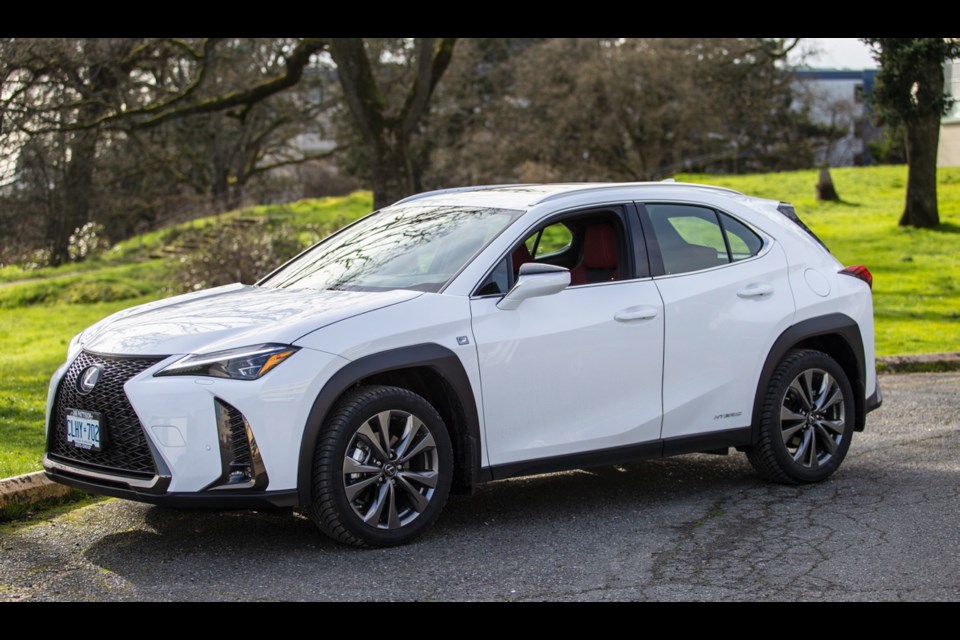In a market where everything seems to be getting bigger and bigger, the subcompact Lexus UX is like a breath of fresh air in a stuffy room.
SUVs and crossovers are everywhere these days. And every day you hear of a manufacturer introducing larger and larger models that can carry more cargo and passengers.
Lexus has quietly gone the other way, with a model that hits all the high notes in a subcompact body.
It is a segment that has seen a number of luxury entrants, from the Volvo XC40 to the BMW X1.
But Lexus has a winning card up its sleeve.
Luxury brands traditionally play up on their vehicle’s performance versus regular brands. Lexus, on the other hand, can tout their fuel efficiency as a trump card instead.
The UX is available as the 200, with a 2.0-litre four-cylinder that produces 168 horsepower, or the 250h, with an Atkinson-cycle 2.0-litre gasoline engine mated with Lexus’ fourth-generation electric hybrid system that cranks out a combined 181 hp.
I drove the latter car with the F Sport Series 2 package.
If you like luxury, yet want to drive something socially conscious at the same time, the UX hybrid is your vehicle.
With a gentle foot, you could be able to consume a miserly 5.7 litres of fuel per 100 kilometres in the city and 6.2 on the highway.
The hybrid drivetrain technology, from parent Toyota, works seamlessly and effectively. While the competition fits engine stop/start to its vehicles, the electric motor in the hybrid drive in the UX provides propulsion until about 10 km/h.
The UX will, under light load, revert to electric power even at higher speeds. The transition is completely transparent — the only way you can tell is when the vehicle tells you of the change.
A drive-mode selector allows you to choose Eco or Sport if you find the middle-of-the-road Normal setting not aggressive enough for your driving style.
Choose Sport when you desire an extra urgency to your drive, but don’t expect too much. The UX will get from zero to 100 km/h in about nine seconds.
The regular UX is front-wheel-drive only. The hybrid UX sends engine power to the front wheels via a CVT transmission and uses an electric motor to power the rear wheels, making it all-wheel drive.
If you choose to take to the back roads, you will find the UX 250h a pleasant companion.
My tester had the F Sport package, which includes a sport-tuned suspension and 18-inch wheels, among other performance upgrades.
The interior is a knockout, with an edgy design and a youthful vibe. My tester had an attractive contrasting red-on-black colour scheme.
The traditional analog gauges have been replaced by an eight-inch customizable digital display in front of the driver.
The 10.3-inch infotainment screen is on the top of the dash. It is flanked by an conventional analog clock — a nice, classy touch.
The system is hamstrung by a too-sensitive touchpad controller that I found frustrating to use.
As if to compensate, Lexus has relocated the audio system’s volume and tuning knob to the outside edges of the centre console. It’s an unconventional location, but it works great once you are used to it.
Although the UX may be the least-expensive Lexus, you wouldn’t know when sitting in it. Fit and finish is excellent, with attention to detail evident throughout. My tester was the top of the line and came with items such as heated and ventilated front seats, power adjustable seat belts, a premium audio system and supportive seats.
The only thing that Lexus could not change is the tight rear quarters. If you are on the tall side, you might want to think twice about having anybody sit behind you.
The cargo capacity on par with this segment, with 486 litres of capacity.
However, the liftover height makes it difficult to load heavy cargo. That’s disappointing because there doesn’t seem to be anything — not even a spare tire — underneath the floor.
The UX comes with a comprehensive driver-assistance suite. Standard features include forward collision warning, automatic emergency braking, bicycle and pedestrian detection, adaptive cruise control, lane-departure warning, lane-tracking assist and traffic-sign recognition.
The parking-assist system uses sensors to detect objects when you are backing up, and will apply the brakes automatically if it senses an imminent collision.
As the entry-level vehicle to the Lexus brand, the UX is well-suited to its role. It is affordable (for a luxury vehicle), looks attractive on the outside and the well-appointed cabin is a great place to dwell.
THE SPEC SHEET
Type: Luxury sub-compact SUV, gasoline-electric hybrid, front engine, all-wheel drive
Engine (gas): 2.0-litre four cylinder, 150 hp at 6,000 r.p.m., 140 lb.-ft. of torque at 4,400 to 5,200 r.p.m.
Engine (electric): 107 hp and 149 lb.-ft. of torque
Engine (electric) rear wheels: 7 hp and 41 lb.-ft. of torque
Battery: 24 kWh nickel-metal hydride
Total engine (hp): 181
Transmission: CVT
Dimensions (mm): Length, 4,495; width, 1,840; height, 1,540; wheelbase, 2,640
Curb weight (kg): 1,635
Price (base/as tested): $40,000/ $50,975 (includes $2,075 freight and PDI and $100 AC tax)
Options: F Sport Series 2 $8,900
Tires: 225/50 R18 on alloy wheels
Fuel type: Regular
Fuel economy (L/100km): 5.7 city/ 6.2 highway
Warranty: Four years/80,000 km new car, six years/110,000 km powertrain



